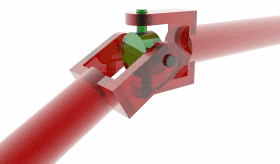mathematically - a universal joint is unlike a CV joint. As you bend the joint, while the input shaft moves at a constant velocity, the intermediate or output shaft rotates a sinusoidal velocity, which is to say, + or -, depending on what phase of rotation the joint is in. So if you keep the final output shaft in the same phase as the input shaft, it doesn't matter what the intermediate shaft is doing in between. Out of phase, you double the variation, so it's ++ or --, depending on what part of the phase it is. That would lead to stiff/loose parts of the rotation, corresponding to a fast and slow steering rack. Wouldn't be nice when countersteering a slide for instance. In Phase means the forks on the outboard portions of the universal match ie they are both vertical/horizontal/clocked the same.

